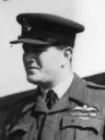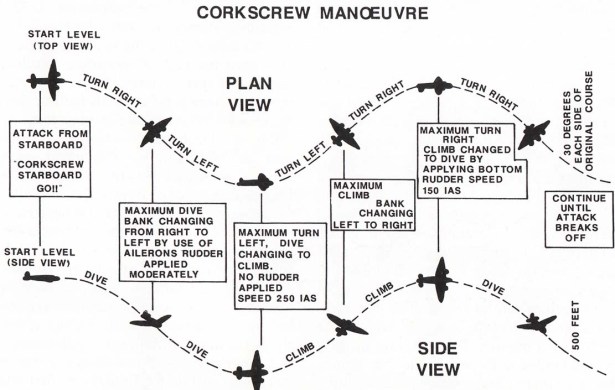Corkscrew Port – Go!
……………then the fear of the unknown entered the Crews’ minds. Has the Fighter seen the Aircraft? Will it Attack? How many Night-Fighters are out there? Is this the decoy while another is forming up to attack from another direction? A 1,000 things would run through the Observers mind. What seems like minutes, was often nanoseconds. Before…..
“Fighter Coming In On Port — Stand By! — Corkscrew Port — Go!”
Those were the words that all Bomber Crews hated to hear, the odds were not in their favour. Their Aircraft were much slower than the Fighter, less manoeuvrable, and heavily laden with 1,000s of gallons of petrol, oil and of course the Bomb Load. Any of which, could easily ignite or explode from a single Cannon Shell being placed in just the right location. The Bombers Defences were limited offensively; and while “Kills” were claimed by Bomber Crew Gunners, it was more by luck that a Gunner would have the time and more importantly the range of his Guns to be able to fend off a Fighter, let alone inflict sufficient damage upon it to force it to Break-off or better still to be Shot-down. However, the combination of the Gunners reactions and the “Corkscrew” Manoeuvre were often was enough to give the Bomber and its Crew a fighting chance or at least cause the Fighter to miss its Target and may be Break-off to find another prey. Therefore the theory behind preventing an Attack was to “prevent being detected”, or if detected “finish the Combat without being seriously damaged.
Thus the Corkscrew Manoeuvre or Barrel Roll was developed. Designed to present the Bomber to the Fighter in a manner that the Fighter could Line up for Attack and at the moment the Attack began the direction & altitude of the Bomber would be violently changed through a Series of Direction & Altitude changes.
The diagram shows the “Corkscrew” Manoeuvre assuming an Attack from the Starboard side. It would be reversed if the attack came from Port. Throughout the manoeuvre the Pilot was meant to call the next part out so that the Gunners could adjust their Aim…. Going Down to Port….Going Up Starboard… Rolling… etc”
- The Pilot (originally cruising at 200-225 mph) opens his Throttle & Banks at 45° to make a Diving Turn to Port (because the Enemy Aircraft is on the Port, reverse the manoeuver if Enemy is on Starboard.); descending through 1,000-ft in only 6-secs, the Bomber reaches a speed of nearly 300 mph. After the 1,000 ft Descent, the Pilot pulls the Aircraft into a Climb, still turning to Port.
- He reverse the Turn, halfway through the Climb which has caused his speed to fall sharply, possibly forcing the attacking Night Fighter to overshoot his Target.
- Regaining his original Altitude, with speed down to 185 mph and still in the Starboard Turn, the Pilot pushes the Aircraft down into another Dive.
- Picking up speed in the Dive, he Descends through 500-ft before reversing the direction of the Turn.
- If the Fighter is still on his Tail, he stands by to repeat the Manoeuver. The physical effort required by the Pilot has been compared with that of an Oarsman pulling hard in a Boat Race.
‘You were flying straight & level, and the snap order came from your Gunnery Crew, “Corkscrew Port!” or “Starboard, Go!“. Immediately you went right over, till your Wings were almost vertical, and at the same time, straight down as hard as you could go. When the Airspeed reached somewhere around 350 or 400-knots, (the Wings were supposed to drop off at 300, – but they never did.) You rolled off the other way, and then Climbed as steep as you could, up on your Tail, until you were almost stalling, and then round & down again. So you actually went through the sky on a Corkscrew or Helical Path.’
The term Barrel Roll, by itself, most often refers to a Helical Roll around a straight Flightpath, the purpose of which is to slow the relative forward motion (downrange travel) of the Aircraft. This can help a Defender to force an Attacker, who is usually behind the Defender, to fly out in front, called Overshooting. This can also help an Attacker to prevent an Overshoot. This often forces both Planes to continue through a series of Rolls known as a Rolling Scissors Manoeuver. A Barrel Roll is also often used to check blind spots while remaining on a steady Flightpath.
The next question is what do we do with an Attack from the Front area since our Turrets will not move left or right. If the Attack is basically head-on point the Nose towards the Enemy Plane just like a Fighter. Otherwise, use the Corkscrew. It was rare that a Lancaster was attacked head on during Night Operations.
The Corkscrew Manoeuvre was evolved as a Defence against Radar Equipped Night Fighters or those operating visually (Wilde Sau-Wild Boar) on dark or poor visibility nights. Bearing in mind that RAF Heavies only operated at Night until very late in the War. The idea being that it was difficult for the Fighter to pick up the change in direction quickly enough and ended up swinging around like a ball on the end of a string. The Manoeuvre could be quite effective. A German Night Fighter Pilot under interrogation said that once he followed a Corkscrewing Lancaster for ½-an-hr and never once got into a position for a Burst. The success depended of course on the Gunners sighting the Night Fighter early enough – not easy. When the Germans started to use the upward-firing Schrage Musik installations, this became even more difficult.
The last-second hard turn towards the Fighter to maximise the Deflection Angle and give the Gunners a chance for a Shot as he passed by. The idea of the Day Fighter Affiliation Practices was for the Bomber Crew to practice their Handling & Crew Coordination and for the Fighter to practice his Deflection Estimation. The initial action was when the Gunner called “ready to Corkscrew Port/Starboard” just before the Fighter was trying to get into effective minimum range and then use the word “Drop” which then required the Pilot to haul the throttles back which would cause the Aircraft to slow rapidly and suddenly bring the Fighter into Range and a terrible surprise. At this point the Corkscrew would commence under the Gunner’s commands. Then the Pilot would open the throttles again to where they were previously. They practiced the Manouver many times over The Wash with Mustangs who could not get the hang of it at all, and were ‘beaten’ each time.


Was there an argument against the development of a belly gunner in the Lanc ? Never seem to see it mentioned .
Wouldn’t this have been added security for the craft and crew if for instance a JU88 parked itself below as they often did ?
The US B17 for example obviously bristled with arms including belly and door gunners whereas the Lanc was mainly Tail and Mid Upper Turrets
LikeLike